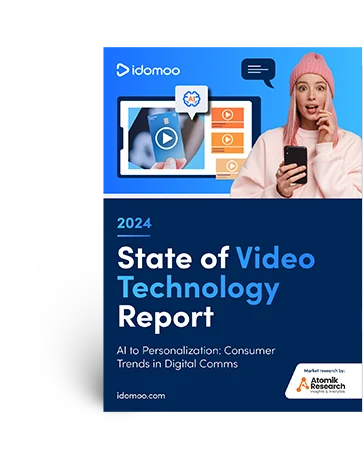In a time where every click, scroll and purchase contributes to a unique digital footprint, consumers expect to be remembered and catered to. After all, no one wants to be bombarded with messages, offers and recommendations that are irrelevant to them.
With 80% of customers more likely to purchase from a company that offers personalised experiences, delivering those tailored interactions should be a top priority for today’s brands. And that requires investing in personalisation technology.
But what exactly is personalisation technology? At its core, it includes the various personalisation tools, platforms, and solutions that make it possible for businesses to deliver hyper-targeted experiences across touchpoints.
Think of the engine that drives recommendations on ecommerce sites, the algorithm that predicts what shows you’d like to watch next or the intelligence behind targeted advertising campaigns. These are all powered by personalisation technologies!
So whether you’re a business dipping its toes in the world of personalisation or a brand looking to optimise its current tech stack, this guide is here to cover the essentials. But first? Let’s touch on how personalisation’s evolved.
The Evolution of Personalisation
Personalisation is far from a new concept. Brands have been working to craft tailored experiences for their customers for decades. Initially, though, personalisation efforts were fairly basic, often limited to the simple inclusion of a first name or the acknowledgment of a past purchase.
Post on
However, with technological developments like big data, sophisticated algorithms and machine learning, businesses are now able to offer seamless, hyper-personalised physical and digital experiences. Customer preferences, behaviors and even contextual factors like location and time can now be used to offer highly personalised recommendations, messages and deals.
For instance, an online retailer might send a happy birthday message to a loyal customer, offering an exclusive deal on a curated selection of products based on their past purchases, browsing history and preferences. The result? A personalised, customer-centric interaction that not only enhances user satisfaction but also improves customer loyalty and conversion rates.
Adding AI to the Mix
These days, artificial intelligence is also playing a major role in brands’ personalisation capabilities. AI allowed businesses to dramatically scale up their personalisation efforts, letting them easily create personalised content and experiences, often in just a few clicks.
One example is Idomoo’s own Enterprise AI Video, an AI video tool that lets you personalise at scale. Trained on your brand’s content, it can seamlessly integrate customer data and generate millions of Personalised Videos, from tailored product recommendations to special birthday messages.
market study

All in all, we can expect personalisation technology to continue to evolve, making personalised experiences easier to deliver and, as a result, more widespread. No doubt, businesses that invest in personalisation will gain a competitive edge in meeting the expectations of their customers.
Key Elements of Personalisation Technology
Crafting a tailored experience for someone like a partner, friend, family member is one thing, but personalising experiences for every single one of your customers? That takes some real technological horsepower. Let’s break down the complex array of technologies that drive personalisation behind the scenes.
1. Data Collection and Management
Personalisation starts with data — and lots of it. From demographic information and purchase behavior to browsing history and interactions with content, all kinds of data are collected and analysed so that brands can better understand each customer.
Customer data platforms (CDPs) play a huge role here, collecting and unifying customer data from various sources to create a single customer view. Identity-resolution platforms can also be used in tandem with CDPs, working to link and resolve identities across different devices and channels, while data management platforms (DMPs) optimise data for personalised marketing campaigns and audience segmentation.
2. User Profiling
User profiling involves creating detailed profiles for individual users or customer segments based on the data collected, essentially allowing businesses to keep track of each customer for personalisation down the line. In addition to CDPs, customer relationship management (CRM) systems like Salesforce or HubSpot can also help companies organise and manage these profiles effectively.
3. Analytical Models
Analytical models are another key element of personalisation technologies, making good use of all your customer data by using them to predict customer behavior and preferences. From Amazon’s product recommendations engine to TikTok’s For You page algorithm, these models analyse past interactions to anticipate future needs, allowing brands to deliver relevant content and experiences.
According to McKinsey, building a “set of centralised analytic models in the CDP” is one approach savvy marketing leaders are implementing to ensure consistency. Machine learning and AI are also increasingly being used to find patterns undetected by static models. Overall, experts recommend being agile and regularly experimenting with the new decisioning tools and solutions that often emerge.
4. Personalised Content
With insights in hand, it’s time to make personalisation a reality through tailored content and communications. This means developing a range of personalised materials to present throughout the customer journey, including personalised graphics, written copy, videos, emails, ads, web and app interfaces and even elements for face-to-face interactions.
Of course, creating bespoke content one by one for each customer is not only time-consuming but also impractical. Fortunately, there are plenty of solutions and technologies available that enable businesses to design personalised content at scale.
Take dynamic content optimisation (DCO) platforms, which can automate the process of producing personalised ads. Many email marketing platforms also have similar capabilities, allowing you to launch large-scale personalised campaigns. There are even content management systems (CMS) that let you A/B test different web content variations to identify the most effective messaging for individual visitors.
And we can’t leave out platforms for creating Personalised Video content. Here at Idomoo, we make it easy for you to produce millions of tailored videos for your customers. As the example below shows, each video is dynamic and data-driven, including only the most relevant details and scenes that will resonate with each recipient.
In short, these invaluable technologies collectively empower enterprises to deliver diverse types of personalised content, driving both customer retention and uplifts in customer engagement.
5. Real-Time Changes
Personalisation often involves making real-time changes based on user interactions and behavior. As such, some personalisation software and platforms allow you to automate these changes, dynamically adjusting information based on the user’s current context or how they interact with the content.
Here’s a look at this kind of technology in action. Notice how the video automatically updates in real-time based on live data, allowing it to always be relevant and up-to-date for each viewer.
From showing the most up-to-date pricing to updating customers on a product’s availability, the use cases for real-time data-driven videos are limitless, offering brands an innovative way to engage their audience.
6. Cross-Channel Distribution
Personalised experiences should be delivered seamlessly across various touchpoints, whether it’s a website, mobile app, email or social media. Cross-channel distribution is a must-have for personalisation technologies as it allows businesses to implement campaigns across multiple channels and ensure a consistent experience wherever the customer engages.
7. Data Privacy and Security Measures
With increasing concerns over data privacy, ensuring the security use of customer data is essential. From performing regular security audits to achieving information security certifications like ISO 27001, the best personalisation solutions and tools have top-notch data security protocols in place to ensure the safety of their client’s sensitive information.
Ultimately, personalisation technology is a blend of various components all working together to make experiences unique for each customer. And when businesses tap into this power, they can create tailored experiences that not only resonate but keep customers coming back for more.
Embracing Innovation
Incorporating personalisation technology into your marketing efforts isn’t just about checking off a box; it’s about optimising your personalisation strategy and working smarter, not harder, to hit your business goals. Whether you’re a seasoned player or just starting out, there’s never been a better time to embrace the numerous innovative technologies available.
Ready to elevate your brand’s impact? Reach out to us today to discover how Idomoo’s Next Generation Video Platform can take your customer experiences to new heights.



